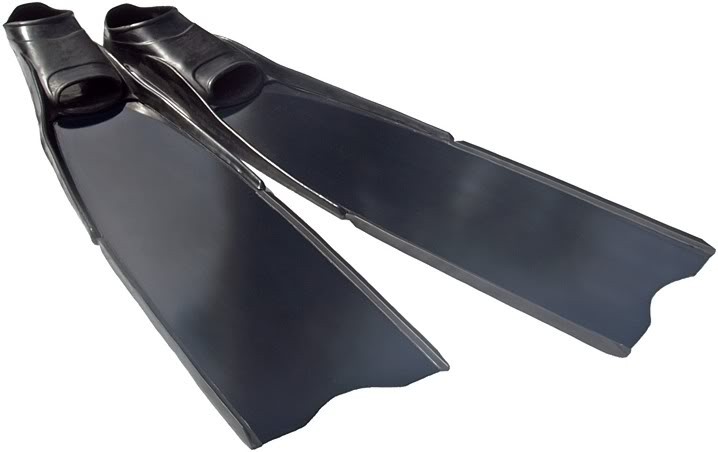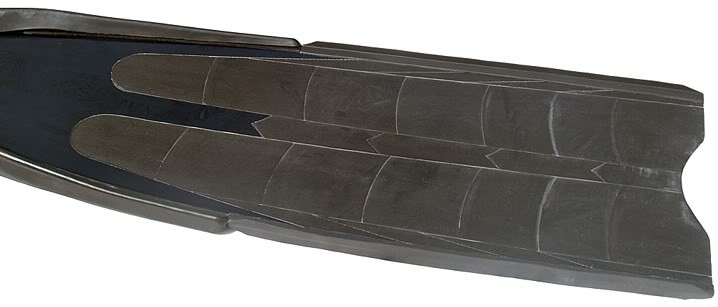Also comfortable foot pockets, and priced pretty decent. I definitely need to move up to CF later this year.
Freediving class fins
-
-
I just signed up for the FII level 2 in April. PM Sent, Dan
-
I'd be very interested to hear what you have to say about training. I'm trying to go into the course with an open mind and not be the guy that thinks I already know how to do it, but anything else I can take in, I most certainly will.
-
I'd be very interested to hear what you have to say about training. I'm trying to go into the course with an open mind and not be the guy that thinks I already know how to do it, but anything else I can take in, I most certainly will.
I train with William Trubridge who is the ultimate researcher of freedive training.
The latest theory is to train to build up your co2 tolerance. You do lots of sets on short intervals. Your dive/swim time needs to be longer than your rest time,. Send me a pm for a detailed description. -
Carla are you able to do any pool training come fall ? I need to start reversing my aging process .
Cheers, Don
-
Took PFI in 07, with Martin Kirk and Mandy. Myself and many of the other students were using Picasso Black teams.
The instructors never made any comments on any gear. However, eveyone one of them and their assistants were wearing C4s while diving.
Fins can be kind of like spearguns. There are different situations that call for different fins. I have several pairs of fins that I use depending on what type of diving I am doing.
In California I most often dove from shore in water that was less than 50' deep and would spend 6-8 hours in the water at a time. I needed a fin that was better suited for surface work rather than deep diving. A medium stiffness blade worked very well for this. Going too soft was not a good thing because of currents. My prefferred blade was the Omer Pegasso in med stiffness.
Deeper diving at the islands got me interested in the DiveRs and I found them to work quite well. Their length and parabolic bend made deeper diving almost effortless. However, the same characteristic was also my worst nightmare when it came to fighting bigger fish. The blades were just too slow to respond. If I were to use these fins now, it would be strictly for deep diving on reefs for smaller fish.
Most of the diving I do now is on the rigs. Very little surface work. Most of the diving is straight up and down and the fish here, can get big; and for the most part pound for pound are stronger than any otehrs I have ever dealt with, regardless of species. I prefer a shorter stiffer blade for this type of diving. I have never had to dive any deeper than 70'. We get wicked currents around here. My fins need to respond. I am currently using a stiffer carbon blade and like it very much. As a few others have already stated, I would never go back to plastic or FG blades.
-
I'm with you. If I can choose, I will never dive again with plastoc fins. Period.
+2
-
When I took FII, Martin and Niki commented more on the footpockets than the blades. Their comments were that the footpockets should be stiff and tight for transference of power. To check the footpocket for stiffness, hold the back of the footpocket with your hand on the back and your thumb inside the pocket and hold the fin level. The footpocket should support its weight and the blade's weight without folding.
As for blades, they pretty much said what everyone already knows - carbon is better than fiberglass, fiberglass is better than plastic. The only fins they had anything negative to say about were Cressi Garas (too soft of a footpocket) and OMER Stingrays (funky bend during the kick cycle).
On the open water days, Martin was using Nemos and Niki was using C-4s. Although, you could have strapped garbage can lids to their feet and they still would have swam circles around anyone.

-
Where they commenting on the Stingray blades or the footpockets themselves?
-
Quote
Where they commenting on the Stingray blades or the footpockets themselves?
They said that the newer OMER footpockets were hit or miss (some are stiff, others are soft). The Stingray (the plastic fins) had an odd curvature when flexed. If you have access to a pair, flex them back and you'll see it doesn't produce a smooth curve.
-
Stingray footpockets have very stiff tendons. The blade will not flex at all in the area between the toes and the end of the tendons.
omer Millenium foopockets are hit or miss for stiffness, except if you buy from Pursuit. I make sure that all the f/p I get from omer are consistent in stiffness, which should be moderate.
Matt, thanks for the input. When did you do FII?
-
I took the class (Level II) about a year ago. And for the record, I was using FG SpecialFins in hard with OMER footpockets. Today I'm using Pursuit C90s with Beuchat footpockets. Although I still use the SpecialFins for shallow artificial reefs and stone crabbing (or anywhere else I'm banging against the bottom).
-
Bingo!
Not putting you on the spot Byron, according to the information you received from the instructors, what specifically is required from a "workout fin" that the waterway blades provide?
Dan.
Byron uses the Nemo ( waterway) for workouts for the best power but they are too tight and uncomfortable to wear for long periods of time ( spearfishing). The recommended size is smaller (for the best power) than what he would normally use and thus uncomfortable for longer wearings. Pro freedivers put their competition fin on for one dive then take it off. We wear comfortable fins to spearfish or safety other divers.
I think it is best to get fins that are comfortable for all use. Footpockets that don't cramp your feet and a blade that suits your purpose and kick style.
Carbon blades are great for performance but if you are a little careless or do a lot of rock / reef diving they are more fragile.
Fins like masks,wetsuits, etc are not a one type suits all item. -
Carla are you able to do any pool training come fall ? I need to start reversing my aging process .
Cheers, Don
sure , I will be traveling a lot in September- October ; World Championships in Greece (depth) and Italy ( pool )but contact me when you are ready I'll be around !
-
Thanks Carla, will do, I need to start searching the flickering bottom for dimes and gum.:D
Cheers, Don
-
I started this thread asking this question because I was present at a freediving pool training session and was amazed to see that every single diver, there were about 15, including the instructor was using the obsolete Waterway blades. In case someone doesn't know which blades those are here are pics. The Waterway blades were very good at the time they came out because they were practically the first fiberglass fins on the market. They've now been displaced by better fiberglass blade manufacturing methods and blades with built in angles, and furthermore by carbon blades.


At that training session I was told by the participants that my carbon blades are no good for what they were doing. When I asked why I was told that they don't stand up to pool training ie. they break. Since I've never even come close to competitive freedive training before I had this notion that competitive freedivers would be very up to date on the best diving equipment. I was really shocked to meet with such resistance to what I knew were superior fins.
Since I wouldn't accept the idea that the waterway blades are better than Pursuit carbon fins for any kind of application, I thought a lot about the possible reasons for this attitude. I think I figured it out. Competitive freedivers, in training, don't spend so much time in the water as we do spearfishing. Over the course of a day diving 6-8 hours, every little bit that helps us feel more comfortable and minimizes effort such as in the case of the lighter and more reactive carbon blades, will really add up. We naturally gravitate towards this kind of equipment. In the case of the training freediver this may not be a consideration. On the contrary using a difficult fin may be a way of using more resistance so that a consequent short one time "real" diving effort would seem easier if better fins are then used. I feel compelled to say that if this is the mentality of competitive freediving then it is very far removed from what diving is about to me.
-
I feel compelled to say that if this is the mentality of competitive freediving then it is very far removed from what diving is about to me.
I would have to agree on that, whole-heartedly. I think the two get interwoven way too much.
-
competitive freedivers do not use bi-fins anymore- all use monos when doing the comp. deep dive then put on bi-fins( c4's or whatever they prefer) to safety/film other divers .We spend a lot more time in the water than that one dive because we love the ocean as you do.
My students usually start out with bi-fins because that is what they have then quickly move up to the more efficient ( and expensive:angry5:) mono.
IMO- PFI and FII recommend Waterway plastic fins because of their arrangement( selling product) with that manufacturer and he does not make carbon blades.
Here is a photo of new ( in testing stages) HUGE carbon mono made in GreeceDan; I will be testing some new carbon blades and I should try the Pursuits. We could recommend them for the safety divers and competitors to use when not deep diving.
BTW: your thoughts about competitive divers are totally wrong.We will talk about this some other time
-
IMO- PFI and FII recommend Waterway plastic fins because of their arrangement( selling product) with that manufacturer and he does not make carbon blades.
You probably meant to say fiberglass not plastic, and I think you may be right. It's pretty lame, from the end user's point of view, that being in a position of trust PFI and FII recommend an obsolete fin.
-
FWIW, I took the FII course last weekend. As far as the students go, the fins were all over the place from Cressi's (me) to C4's. The instructors used different fins for the pool and boat dives. No doubt that the pool training for the class will jack up carbon fins.
Martin was pretty neutral w/ fin recommendations. He talked about what to look for in a fin and foot pocket, but never committed or pushed specific brands.
Personally, I will be switching fins, but not sure to what. I learned that I would benefit from softer fins, but am not sure if I will go fiberglass or carbon. I'm not an 60+ ft hunter and am wouldn't expect the fins to make an immediate difference. I am a little concerned about carbon fins and multi day bahama trips. I have a size 13 foot and am more concerned about the foot pockets than the blades.
Create an account or sign in to comment
You need to be a member to leave a comment.

